Paradise (1982) promised romance in the desert — but what audiences really remember is one star who carried the whole film
Some movies stay with you because they had something meaningful to say, even if it was subtle. Others linger for entirely different reasons—because of a striking image, an unforgettable scene, or a performance that seared itself into memory whether or not the movie deserved it.
Paradise (1982) belongs firmly in the latter category.

When I first saw it as a kid, I was too young to fully grasp the language of cinema, too inexperienced to appreciate nuance, and yet old enough to know when something felt cheap. Like many others of my generation, I watched it not because of its reputation as great art but because it promised something exotic, daring, and slightly taboo. Looking back now with older eyes, the truth is much clearer: this was a film that looked beautiful on the surface but was empty at its core, a glossy misfire dressed in soft lighting and artificial myth.
The setup is essentially Blue Lagoon with a desert setting and slightly altered window dressing. Two young characters—Sarah, played by Phoebe Cates, and David, played by Willie Aames—find themselves stranded in the Arabian desert after their caravan is attacked. On paper, it could have been a story about resilience, survival, or the coming-of-age transformation of two people forced to rely on one another. In execution, it became a meandering tale of sand dunes, animal cameos, cardboard villains, and contrived romance. There are camels, there are sandstorms, and there are hostile tribesmen, but none of it carries weight. The pacing drags, the action feels halfhearted, and the story predictably moves toward “romantic” beats that never land with sincerity.

Willie Aames was miscast from the start. Known primarily for television work, he lacked the screen presence to carry a feature film that required a blend of charm, vulnerability, and depth. His performance is wooden, his dialogue flat, and his chemistry with Phoebe Cates nearly nonexistent. Scenes that should suggest connection instead feel awkward, like two actors reading lines without ever truly engaging with each other. He delivers lines as though he’s reading them off a cue card, and his attempts at dramatic intensity fall flat.
Phoebe Cates, however, manages to shine despite the limitations of the material. She has an undeniable charisma, a natural ease on screen, and a beauty that explains why audiences remembered her long after
Paradise faded. She was only eighteen when the film was released, yet she carried herself with a confidence beyond her years. But even her presence couldn’t disguise the weakness of the script. The dialogue she was given often sounded like excerpts from a clumsy romance novel, filled with overwrought declarations and clichés. Her performance suggested potential, but the film itself never gave her the chance to show more than surface charm.

The film’s central problem is that it wanted to be about love blooming under harsh conditions but delivered only a hollow, staged version of intimacy. Characters go through the motions of closeness without ever developing a believable emotional bond. Instead of chemistry, the audience gets choreography. Instead of romance, they’re given posturing. It’s all smoke and mirrors, with none of the heat or tenderness that makes cinematic love stories resonate.
Filmed on location in Morocco, the landscapes are undeniably gorgeous. Sweeping desert vistas, ancient ruins, and golden sunsets create the illusion of grandeur. The cinematography captures moments that are striking on their own—riders crossing sand dunes, long shadows stretching across barren plains, or the silhouettes of figures against a glowing horizon. But this beauty is only surface-level. The cultural setting is reduced to little more than set dressing, with local tribes depicted as generic villains and little effort made to provide depth or authenticity. What could have been a story enriched by place and culture instead becomes little more than a travel brochure dressed up as cinema.

Director Stuart Gillard never seemed certain of the kind of movie he wanted to make. Paradise drifts uncomfortably between genres: part adventure film, part romance, part survival drama. In trying to be all of them, it becomes none. Scenes linger too long, dialogue trudges without spark, and potential tension evaporates as quickly as it is introduced. Even the villains, meant to provide urgency and danger, fade in and out without leaving much impression. By the time the story reaches its climax, the sense of threat feels more like a formality than a genuine obstacle.
Yet, despite its glaring weaknesses, Paradise managed to survive in the cultural consciousness. It wasn’t remembered for artistry, for strong performances, or for compelling storytelling. It endured largely because it was just provocative enough to catch attention during an era when VHS covers and late-night cable schedules could make or break a film. The marketing leaned heavily on imagery rather than substance, and for many viewers, the movie became less of a cinematic experience and more of a faint adolescent memory.

Looking back today, there’s no hidden brilliance waiting to be rediscovered. It’s not art, nor is it even good trash. It’s a mirage—a glossy postcard of desert romance that evaporates as soon as you look too closely. What remains is the faint echo of what the film represented to a generation at a specific moment in time: a mix of fantasy, curiosity, and fleeting spectacle.
The final word is simple: Paradise looked like a feast, but it was little more than sugar water served in a fancy glass. Two points go to Phoebe Cates, whose star power transcended the weak material, and to the cinematographer, who tried valiantly to make a dime look like a dollar. The rest? Sand, empty promises, and regret.





